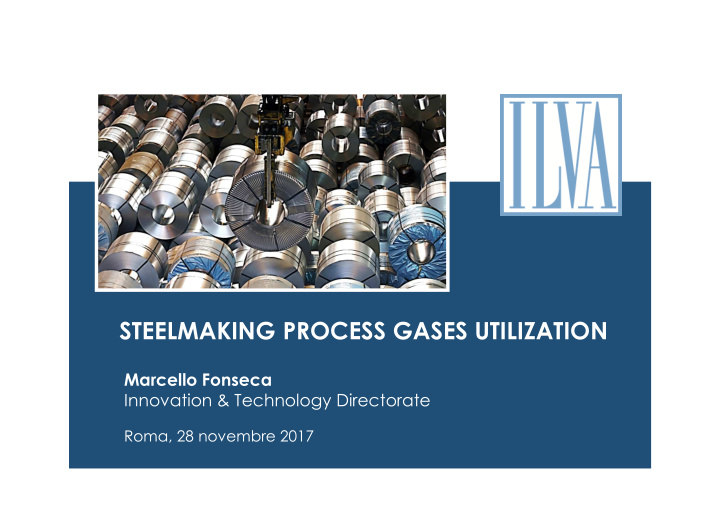



STEELMAKING PROCESS GASES UTILIZATION Marcello Fonseca Innovation & Technology Directorate Roma, 28 novembre 2017
Industrial Symbiosis ILVA – Taranto Energia Symbiosis . Coke Oven Gas (COG), Blast Furnace Gas (BF gas) and Basic Oxygen Furnace Gas (BOF gas) constitute the basis of the energy system in an integrated steelworks. Most of the energy demand is satisfied by these gases; the remaining part must be balanced with purchased energy, normally electrical power and natural gas. The steelmaking process gases can be used by power plants, consisting in gas fired boilers or combined cycle gas turbines, for electricity and steam production. There are many plants in Europe of this type while, in Italy, there is only the case ILVA- Taranto Energia in relation to the combustion of COG, BF gas and BOF gas in the same mix of fuels. The net electrical efficiency for existing plants is defined by the range 30%-40% for gas fired boilers and by the range 40%-48% for combined cycle gas turbines. ILVA's process gases contribute to the constitution of mix of fuels, together with natural gas, conventional fuel with higher calorific value, which is burnt in the thermoelectric power plants (CET2 and CET3) of Taranto Energia Srl, located inside the perimeter of ILVA Taranto plant for the production of steam and electricity. The power plants of Taranto Energia Srl, in the past belonging to Edison SpA, use by- products of ILVA plant in order to produce energy. In this way we have a clear case of industrial symbiosis with exchange between two Companies of two different sectors (manufacturing and power).
Taranto Energia Taranto Energia power plants. The CET2 plant is a traditional multi-fuel thermoelectric type with a total electrical power of approximately 480 MW. It is composed of three identical units consisting of a boiler, a steam turbine, a seawater condenser, an alternator and a power transformer. The CET3 plant is a combined cycle in a cogeneration system with a total electrical power of about 564 MW. This also is composed of three identical units each consisting of a compression system for steel gases, three closed-circuit sealed water coolers and for compressor cooling, a gas turbine, an alternator and a gas turbine elevator transformer, a steam recovery generator, a steam turbine, an alternator and an elevator transformer for the steam turbine. These plants have the function of producing steam and electrical energy for the steel plant's networks. The methods of implementing industrial symbiosis include the use of production residues (coke oven gas, blast furnace gas, basic oxygen furnace gas) in order to generate thermal and electrical energy by their combustion in the CET2 and CET3 plants.
ILVA Taranto plant and the city
ILVA Taranto FROM RAW MATERIALS TO HOT ROLLED COILS AND PLATES
ILVA Taranto COIL COLD ROLLING AND COATING
ILVA Taranto HOT DIP GALVANIZING
ILVA Taranto STRIP FINISHING AREA
ILVA Taranto PIPE MILLS nto
Steel production and process gases Gas Siderurgici di recupero Gas Siderurgici di recupero Gas di Altoforno Gas di Altoforno Gas di Acciaieria Gas di Acciaieria Gas di Cokeria Gas di Cokeria Laminati a Laminati a freddo freddo Bramme Bramme Ghisa Ghisa Laminati Laminati Produzione Produzione Produzione Produzione Produzione Produzione a caldo a caldo Ghisa Ghisa Acciaio Acciaio Laminati Piani Laminati Piani Produzione Tubi Produzione Tubi Rottame Rottame e Rivestimenti e Rivestimenti Coils e Coils e Lamiere Lamiere
Taranto Energia CET 2
Taranto Energia CET 3
Taranto Energia fuels Fuels consumption 2014 2015 2016 u.m. Naturale gas (PCI = 34541 kJ/Sm3 equivalent to 8250 3.373.499.799 2.480.296.340 3.007.397.864 Mcal kcal/Sm3) Coke oven gas (PCI = 17794 kJ/Nm3 equivalent to 4250 1.369.615.880 1.023.316.810 1.274.425.107 Mcal kcal/Nm3) Blast Furnace Gas (PCI = 3768 kJ/Nm3 equivalent to 900 2.320.121.590 1.190.311.690 1.872.910.467 Mcal kcal/Nm3) Blast furnace Gas + Basic Oxygen Furnace Gas 3.125.603.657 2.503.831.782 2.762.574.536 Mcal (PCI = 3768 kJ/Nm3 equivalent to 900 kcal/Nm3) Basic Oxygen Furnace Gas (PCI = 7955 kJ/Nm3 equivalent to 1900 15.893.290 22.859.420 18.318.510 Mcal kcal/Nm3) Total steelmaking process gases 6.831.234.417 4.740.319.702 5.928.228.620 Mcal Natural gas 33,1 34,4 33,7 % Steelmaking process gases 66,9 65,6 66,3 %
Energy production of Taranto Energia 2014 2015 2016 ENERGY PRODUCED U.M. Electricity 4.205.977 3.035.264 3.739.702 MWh Steam 489.593 554.973 619.594 MWh Total 4.695.570 3.590.237 4.359.296 MWh
Environmental and Economic results Natural gas saving and CO2 emissions 2014 2015 2016 U.M. reduction Natural gas saving 6.831.234.417 4.740.319.702 5.928.228.620 Mcal kSm 3 Natural gas saving referred to 34,5 MJ/Sm3 828.028 574.584 718.573 CO2 emissions reduction referred to 55,82 t/TJ (ETS 1.596.509 1.107.847 1.385.470 t CO2 directive parameter)
Conclusions Economic and environmental benefits . Steel production in the Ilva Taranto plant, basing on integrated route, also involves the generation of by-products such as process gases as production residues for coking, blast furnaces and steelworks. These gases, being equipped with calorific value, are burned in the Cet2 and Cet3 thermoelectric power plants of Taranto Energia Srl, giving rise to electricity and steam for steelmaking plant users. In this way, environmental and economic benefits are achieved, as the aim is to reuse a production residue, to limit the consumption of natural gas and the CO2 emissions in the full view of sustainable development. Industrial symbiosis is therefore profitable between the manufacturing and energy sectors, meeting the requirements of the circular economy.
Recommend
More recommend